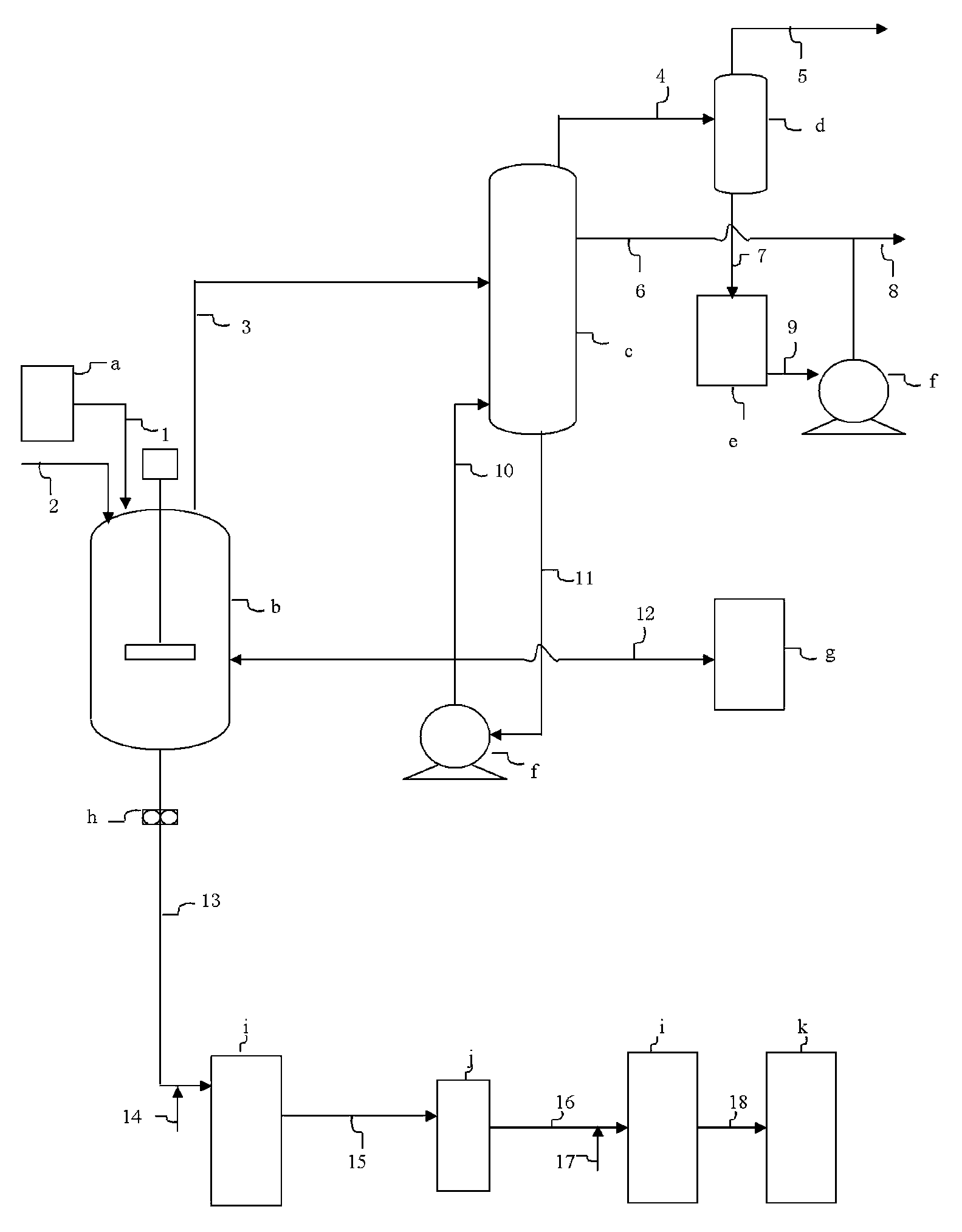Polyester biodegradation agricultural mulching film as well as preparation and application of polyester biodegradation agricultural mulching film
A biodegradable and agricultural mulching technology, applied in the field of polymers, can solve the problems of high cost, inconvenient large-scale production and processing, large and uneven particle size, etc., and achieve simple production and processing, low comprehensive use cost and excellent mechanical properties Effect
- Summary
- Abstract
- Description
- Claims
- Application Information
AI Technical Summary
Problems solved by technology
Method used
Image
Examples
Embodiment 1
[0062] 1) With respect to 1.00 mol of terephthalic acid, the slurry mixed with 4.50 mol of 1,4-butanediol, 1.5 mol of adipic acid and 0.05 mol of allyl polyethylene glycol ether was mixed at 70°C It is transported to the raw material storage tank a, and enters the continuous supply esterification reactor b through the raw material output pipe line 1. At the same time, a 0.005 mol solution of tetrabutyl titanate at 75° C. is sent from the pipeline 2 . The internal reaction temperature of reactor b is 230°C and the pressure is 80kPa. Collect the esterification water, by-products and the remaining polymerized monomer mixture in the rectification tower container c through line 3. After keeping the system stable, collect the esterification water , when the esterification rate reaches more than 90%, in the reactor b, continue to transport the 75°C tetrabutyl titanate solution from the pipeline 2 to the reactor b, and reduce the pressure to 5500Pa, and continue the reaction for 3 hou...
Embodiment 2
[0066] 1) For 0.50mol of terephthalic acid, 0.50mol of naphthalic acid, 4.50mol of 1,4-butanediol, 1.0mol of adipic acid, 0.5mol of adipic acid, and 0.10mol of allyl The alcohol-mixed slurry is transported to the raw material storage tank a at 70°C, and enters the continuous supply esterification reactor b through the raw material output pipe line 1. At the same time, a 0.005 mol solution of tetrabutyl titanate at 75° C. is sent from the pipeline 2 . The internal reaction temperature of reactor b is 200°C and the pressure is 70kPa. Collect the esterification water, by-products and the remaining polymerized monomer mixture in the rectification tower container c through line 3, and collect the esterification water after keeping the system stable. , when the esterification rate reaches more than 90%, in reactor b, continue to transport tetrabutyl titanate solution obtained at 75°C from pipeline 2 to reactor b, and depressurize to 4500Pa, and continue to react for 2.5 hours. The ...
Embodiment 3
[0070] 1) Mix 1.00mol of terephthalic acid, 3.50mol of 1,4-butanediol, 1.00mol of neopentyl glycol, 1.5mol of adipic acid, and 0.10mol of glycidyl methacrylate The slurry is transported to the raw material storage tank a at 70° C., and enters the continuous supply esterification reactor b through the raw material output pipe line 1 . At the same time, a 0.010 mol solution of tetrabutyl titanate at 75° C. is sent from the pipeline 2 . The internal reaction temperature of reactor b is 210°C and the pressure is 60kPa. Collect the esterification water, by-products and the remaining polymerized monomer mixture in the rectification tower container c through line 3. After keeping the system stable, collect the esterification water , when the esterification rate reaches more than 90%, in reactor b, continue to transport tetrabutyl titanate solution at 75°C from pipeline 2 to reactor b, and reduce the pressure to 4000Pa, and continue to react for 2.0 hours. The resulting oligomer 3 wa...
PUM
| Property | Measurement | Unit |
|---|---|---|
| Tensile load | aaaaa | aaaaa |
| Right angle tear load | aaaaa | aaaaa |
| Right angle tear load | aaaaa | aaaaa |
Abstract
Description
Claims
Application Information
 Login to View More
Login to View More - R&D
- Intellectual Property
- Life Sciences
- Materials
- Tech Scout
- Unparalleled Data Quality
- Higher Quality Content
- 60% Fewer Hallucinations
Browse by: Latest US Patents, China's latest patents, Technical Efficacy Thesaurus, Application Domain, Technology Topic, Popular Technical Reports.
© 2025 PatSnap. All rights reserved.Legal|Privacy policy|Modern Slavery Act Transparency Statement|Sitemap|About US| Contact US: help@patsnap.com

